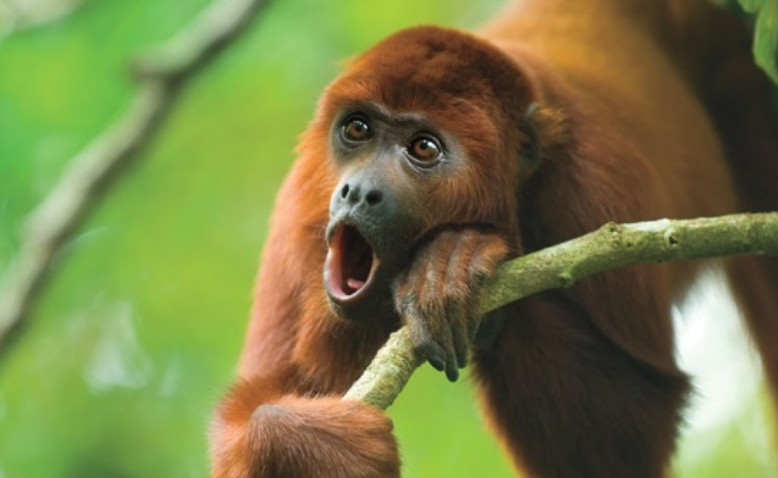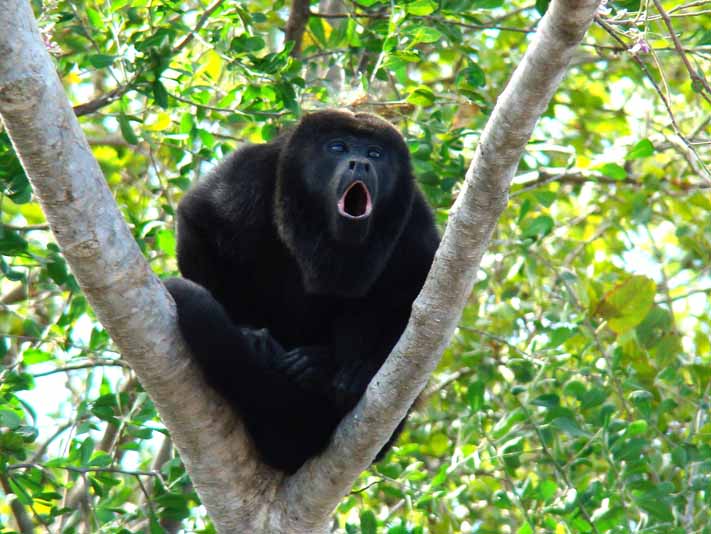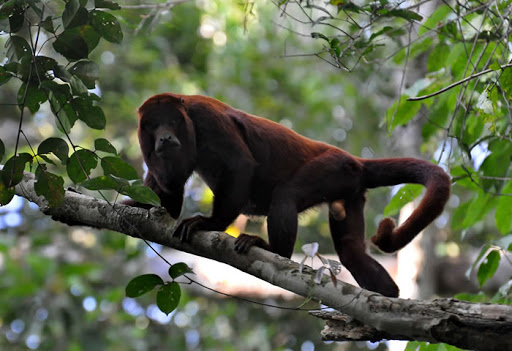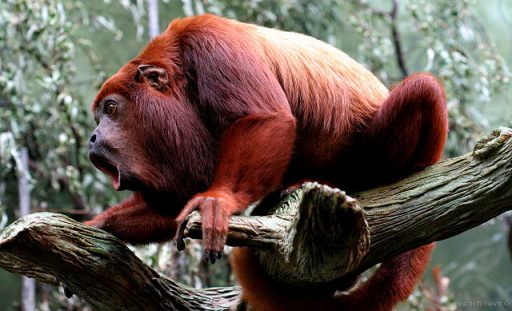Learn about it! howler monkey or saraguato, their diet, how they communicate, the way they reproduce, their conservation, behavior and much more that you do not want to miss, read this great article to the end.

Alouata Palliata
This monkey has different ways of being called, among which we can mention:
- mong monkey
- black preserve
- golden howler monkey
- brown saraguato
- howler monkey
- Tumbes monkey preserve
- howler monkey
But these are not the only ways to be called, there may be countless ways to refer to them, this will depend on the area in which it is located, each culture calls it in some specific way. This is within the species called platyrrhine primate which is in the Atelidae family.
Its body is considered robust and is large, its legs and lower limbs are very long.
Mostly these monkeys have an approximate weight of three kilos with six hundred grams reaching a registered maximum of seven kilos six hundred.
Its tail is also quite long, but in addition to this it serves to grab and hold various objects, being very useful when looking for food and wanting to eat it.
His head is large, on his face there is no hair but it is black or a little dark.
The hair is shiny and soft, of a reddish or brown color, some of its members have yellow spots, in areas such as the hands or on its side. His thumb opposes his index finger, which means that he is easy to manipulate certain elements.
We can find this species from Mexico, in areas such as Chiaspas and Veracruz, to Peru. In the Mexican territory this species has been gradually decreasing.
They mostly live in wooded areas, which are usually very humid, however their preference is towards tropical climates.
Some organizations have declared it an endangered species, establishing that this is primarily because its habitat has been gradually changing, it is also because a large number of people are dedicated to hunting it, and that many others are responsible for trafficking their offspring. . In Mexico, within the black market, this species is in high demand, since its meat is consumable.
These form groups of 20 monkeys mostly, staying together most of the time, in this same sense it is highlighted that both males and females do not remain in the same group where they are born, but once they reach maturity they go to other groups.
Geographic area and habitat
Geographically, you can get more monkeys of this species towards the central zone of America, towards the northwest of South America, as you will see in this segment where the characteristics and habitat of the saraguato monkey. This is the same with many species of Birds.
As mentioned in the previous segment, these are available in Mexico, but they are also available in Panama, Costa Rica, Honduras, Guatemala, Nicaragua, Ecuador, Peru, and Colombia.
This monkey is largely in sympathy with the Guatemalan black howler, which is mostly found in the Yucatan.
It is most likely that it does not adapt to divided and intervened forests, as if the Alouatta could do, while it adapts a little more to closed canopy forests, floodplains and gallery forests.
Another species with which it sympathizes a lot is with the so-called A. Seniculus.
When looking for them in Colombian territory, they are found in those forests that have a high humidity index, also on mountain slopes and in deciduous trees.
When heading towards Central America, that is, Panama, Honduras, Guatemala, Nicaragua, there is a great variety in terms of forests, many of them are low altitude, mangroves are also found, the so-called intervened forests, which are those where the human intervention is not yet visible or very affected, in those places you can find this species.
For greater accuracy, these usually make their home in medium and high canopies, it is important to note that these mostly try not to go to those forests where flooding is very frequent, nor are they frequently found in areas near the coast. Another curious fact is that they have great skill in the water.
If you are in a specific country, you can locate it in the following locations within the monkey habitat:
- Peru: There are only registered habitat data in Pirura and Tumbes.
- Panama: in this case you can find it throughout the national territory.
- Ecuador: Although this monkey does not usually settle in coastal areas, in the specific case of this country, you can get it in the coastal provinces such as: El oro, Los Ríos, Esmeraldas, Manabí, Santa Elena and Guayas, but not in the mangroves but deep into the forest.
- Mexico: you will get them in five states, Tabasco, Oaxaca, Campeche (to the south), Veracruz and Chiapas.
- Costa RicaAs in the case of Panama, in this country you can also locate it throughout its territory.
- Honduras and Nicaragua: All of its national territory.
- Colombia: in departments such as Córdoba, Sucre, Antioquia, Bolívar, Choco, Nariño and Cauca.
Taxonomy and common names
The saraguato or howler monkey is part of the Atelidae family, within this family are the spider, muruquí and woolly monkeys. In addition to this they fall within the Alouattinae, this being a subfamily, being so for specialists in the area.
Until now there is only registered data of three species, which are also by territories as shown in the following list:
1-. In Panama, Costa Rica, Colombia, Ecuador and Peru, the Alouata Palliata aequatorialis species are obtained.
two-. Honduras, Nicaragua and Guatemala, the species is called Alouatta palliata palliata, this species can also be obtained in Costa Rica like the one mentioned above.
3-. Lastly, we have the so-called Mexican Alouata palliata, which is available in Mexico and Guatemala.
There are authors who establish that there are two more subspecies, however it is a theory that has not been fully developed, which may change in the future with the continuation of studies.
When you are near the Caribbean zone, in Colombia, this monkey is mostly referred to in various ways such as: saraguato howler monkey, zambo monkey, black howler, coastal howler, howler monkey and others, just like if you go more towards the part of the Pacific coast of Colombia.
- In the southern part of Colombia it is called mono chongo and chongón.
- In addition, in some territories occupied by indigenous people they are called: Cuara, Kotudú, uu.
- While in Ecuador it is called: Aullaj munu.
Anatomy and physiology
Morphologically this species is very similar to the Alouata, the only thing that differentiates them is the color, since what predominates the most is the black color, as mentioned in the introduction, they also have spots or stripes that are yellowish in color. , sometimes these are located on your palms, but can also be seen on your side or back.
- But in addition to the black color in this species some brown or other gray are obtained.
- If the head is compared with the body of this animal, the first is very large, that is, for its body the size is excessive.
- There is no hair on his face, his color, like his fur, is black.
Its tail is quite useful, it is called a prehensile tail, since it works to hold the elements, be it a stone, a stick, its food, to hang from the branches, among others, it is quite strong and long, this characteristic in particular is common to all who belong to the mentioned family.
In addition, near the tip of the tail it has a kind of pad, which does not have hair, but is fleshy, just like its face.
One of the characteristics of the saraguato monkey Quite interesting is that they are sexually dimorphic, that is, between females and males there are notable differences in their physique, for example in the case of males they are larger than females, the former can weigh from five kilos and a half to almost ten kilograms, while females reach a maximum weight of seven six hundred kilos.
- Another difference between males and females is in terms of the fur on their faces, since the former have more and are longer.
- If you look at the scrotum of howler monkeys, the males have a white color.
- The size also varies, the females reach a maximum of five hundred and twenty centimeters, while the males reach about five hundred and sixty-one centimeters.
- As for the tail, there are also variations, since that of the males is usually shorter than that of the females, in the latter case they reach 609 mm and in the first 583mm.
- Studies have also been done regarding weight, in this case there is an equal average of 6,6 kilograms.
- With all these characteristics mentioned, which differentiate male and female howler monkeys, you will be able to quickly identify any of them, their brain weighs only fifty-five grams.
- As for its diet, it is folivorous, a fact that will be detailed in the following segments.
Behavior of the howler monkey
Within what is the behavior of the howler monkey is its feeding, how it is structured at a social level, locomotion, how to communicate with their peers and other animals and how they reproduce, all this will be detailed by segments, explaining one by one to avoid doubts.
Diet
Mainly, the food of these animals is made up of fruits and leaves, just like that of the monkey, but flowers can also be added, but the latter in less quantity. Seen in percentage form, the feeding is as follows:
- 17,9% in flowers, this being the least consumed.
- 42,1% of various fruits.
- 48,2% of leaves, this is what this animal feeds on the most, but it is quite proportional to the percentage of fruits, leading to a balanced diet.
- Studies have been carried out that determine the time it takes for each species to feed, percentage-wise it is distributed as follows:
- Ficus insipidus: 14,89%
- Cecropia insignis: 2.24%,
- Ficus yaponensis: 20,95%
- Hyeronima laxiflora: 1.99%
- Brosimum alicastrum: 6,08%.
- Lacmellea panamensis: 0.67%
- Platypodium elegans: 5,65%
- Anacardiaceae: 2,63%
- Inga fagifolia: 3,86%
- Poulsenia armata: 3,63%
- But this is not the only classification that exists in terms of food, but there is also a division by family:
- Leguminosae: 9,55
- Apocynaceae: 1,67%.
- Moraceae: 47,79%
- Euphorbiaceae: 1,99%
- Anacardiaceae: 2,62%.
When carrying out these multiple studies, it was determined that these monkeys prefer tender leaves since the mature ones do not generate as many proteins as those, but this was not the only thing that was discovered, rather families such as leguminosae and Cecropia obtusifolia were also a source feeding.
It stands out that these have a higher capacity than other monkeys in terms of foliage since they have a procedure in their stomach that allows the decomposition of those cells that are mostly very difficult to digest.
They also have the ability to select what they will eat, they perceive the leaves that are poisonous or that they are not sure to eat, consuming only those that they consider will not cause them any harm.
In Mexico, at the Chapultepec Zoo, a study was carried out to determine if the food that was provided to the monkeys protected within this enclosure was adequate, with the amount of nutrients and proteins that they need to have a healthy life.
It was carried out for a week, by means of samples that were subjected to chemical analyzes that allowed knowing how much dry matter it contained, how much moisture, crude protein, among other imported elements, the results were:
- In terms of humidity, the contribution was 76,2%.
- By means of dry matter, the part consumed was 23,7%.
- The crude protein was consumed in almost 8%.
So it was shown that they had a good contribution within this zoo.
Social structure
The most common thing in this species is that it has a peaceful behavior, however it is not advisable to rely on this characteristic since they can become a little aggressive on certain occasions.
People dedicated to making animal documentaries spend hours making recordings about everything that different animals do in their habitat, including howler monkeys, they are in charge of studying every detail that allows theories to be made about it, likewise biologists spend their lives in research.
Due to these tasks carried out by these specialists, it has been discovered that in the herds or groups of howler monkeys, there is always a single male leader who is in charge of removing other males from his group and killing the youngest, this can be seen as fitness taken to earn respect.
However, many studies have determined that these actions are mostly carried out when the females are in heat, so there is a great sexual receptivity that drives the males to displace some of their partners and kill others, considering them a threat to reproduce .
They do not like to form large groups, they prefer small herds, they are mostly grouped between six members up to a maximum of 23 members, howler monkeys have rarely been observed in larger groups, however it is noted that these are usually more numerous than the Alouatta Seniculus.
On Barro Colorado Island, a group of 21 members was observed, this being one of the largest recorded to date, the most common is that in each of these groups there are three alpha or leader males, differing in this regard the Seniculus , since these only have an adult leader.
The most common is that between each group there is an approximate distance of 10 to 60 hectares, however when the territory where they live is not so extensive, they can be far from one another from 3 to 7 hectares, as can be the case of Panama in some of its forests, since many of them have an overpopulation of howler monkeys.
According to the recorded data, these are constantly moving in search of their food, traveling up to one hundred and twenty-three meters each day, but they have even been seen to travel up to 596 meters.
The overpopulation of these monkeys in the coastal areas of Panama is due to the fact that in the nearby forests there has been a lot of logging over the years, for which they are forced to migrate to the coasts, so per square km Up to one thousand and fifty species of saraguato monkey are found.
This is clearly different from Costa Rica and Mexico in which per square kilometer, in the first case, 90 monkeys are obtained and in the second case, 23 individuals.
Communication
Although many times it does not seem that animals communicate with each other, the truth is that they do as much or more than humans, each one does it in their own way and whenever necessary.
In the case of the saraguato monkey, it has a very special characteristic, they have vocal displays, where the most common is the howl and on this their name of howler monkey is based.
In the new world this is considered to be the loudest primate howl. When they make this sound, they are warning members of other groups, especially males, but they can also make this sound when they hear planes or other loud noises.
The most common thing is that in conjunction with these howls they make growls, but the latter is made by the females of the groups in the company of the youngest.
There are other sounds made that have been classified as follows:
- Bark, this is done by the male, which is very deep and does it at least four times, they do it when they feel interrupted by something external.
- incipient roar: these have a short duration, just like the previous one, it is carried out by the males of the group.
- Oodle: These are sounds emitted repetitively, like a pulse, they are mostly made by adults when they are upset.
- Loud Roar: this occurs in adult males as a higher pitch at the end of the roar.
- female bark: when the females are disturbed they emit this sound with a higher pitch than usual.
- Accompaniment Roar: This sound is made by both the young and the females, when moaning to accompany the song of the male.
- Moan: when they are afflicted by some frustration they make this type of sound, this can be done by females, youngsters and infants.
- Incipient male bark: It is a sound of the males when they feel annoyed but slightly.
- Squawk: it is a way in which they cry, you can tell this sound because they make a kind of three consecutive notes and infants do it when they cannot find their mother.
- Eh: is when they breathe repeatedly in order to stay in contact, carried out by infants.
- Cackle: this is done by the smallest of the group, a loud and repetitive sound, making it under threat.
- Incipient female bark: It is a muffled sound and they make it when the males feel a little out of it.
- Shriek: it is a sound made as if they were repeating the letter "E" several times but in various tones, made by both infant and adult females.
- Purr: It is very similar to that performed by cats, the smallest of the group do it when they are in the company of their mother.
- Howl: It is very similar to what dogs do, done by all members except the adult male.
- wrah ha: this is done by the mother when she is not near her son, it consists of three syllables.
In the case of the howler monkey, as occurs in the vast majority of primates, they have greater development in the following ways:
- Sight and hearing are the most developed, these being the ones that allow them to go in search of their food and to communicate with each other.
- These senses are followed by smell and touch, the first of which is very useful for feeding by detecting poisonous leaves, in the case of touch also for the selection of leaves and fruits to be eaten.
Locomotion
In the studies carried out on the Saraguato Monkey, the posture and the time they invest in their routine in each area have also been observed and based on this this segment is motivated.
In Barro Colorado, it is estimated that the howler monkey distributes its time of day as follows:
- Their time is mostly spent resting, since 65,54% of their time is spent on this work.
- To mobilize they only use 10,23% of their time.
- To feed 16,24% of his time.
But another study carried out distributes these mentioned times differently, stipulating them as follows:
- The rest guides it in 58,42%.
- Food at 15,35%.
- The displacement 11,4%.
Regarding this last point, it is important to highlight that 70% of the occasions it is mobilized in a quadrupedal position. They rarely make jumps, they are mostly seen hanging from their tail to eat.
Other data from the study reveal that the displacement distribution in quadrupedal form is 47%, while the suspension in its tail is 37%.
The postures in general of the howler monkey are estimated in the following way:
- Standing: 20%.
- Suspended on its tail: 11%.
- Lying down: 12%.
- Sitting: 53%.
Reproduction of the saraguato monkey
Maturity is reached at different times between males and females, the latter are the first to reach this stage at approximately thirty-six months, while the former reach it once they reach their forty-two months.
The sexual cycle of the howler monkey lasts sixteen days, it is most likely that during this time the pheromones have a relevant role, this is because the males of the group smell the genitalia of the females present, but not only this but also they test their urinate.
The leader of the group is the one who has the full right to copulate with the females.
After one hundred and eighty-six days, it is gestated in the female, and they give birth over twelve months, the most common is that it is a single monkey.
The monkey that is born depends on its mother, clinging to her for at least fourteen days, there are even some that cling to her for 21 days, but the mother takes care of them for a year and a half, they climb on them in places where she cannot access on your own.
Conservation
It was mentioned at the beginning of the group that this species was considered an endangered species, as is the case with the White Tiger When observing the IUCN Red List, it is considered to be of minor concern, that is, although it is in extinction, it is still possible to recover its species.
This is distributed in various countries, and throughout these it is considered that there are enough species, so there is no strong threat that will cause their disappearance, even when they are hunted, sold on the black market, their habitat is damaged and they are in high demand. for the consumption of many.
A quite notorious case in terms of the damage they have caused to their habitat is in the Azuero peninsula, in which there is considerable fragmentation of its forests.
While in terms of their hunting, it happens quite a lot in Colombia in Choco to be more specific, they are hunted by the indigenous and the Afro-Colombian population, in this same country there are many forests that have been victims of logging, destroying many forests, so many of this species have been lost.
This species has a high level of importance at an ecological level since it disperses the seeds, by nature it has certain enemies among which the jaguar, the Harpy eagle, the cougar and the ocelot.









